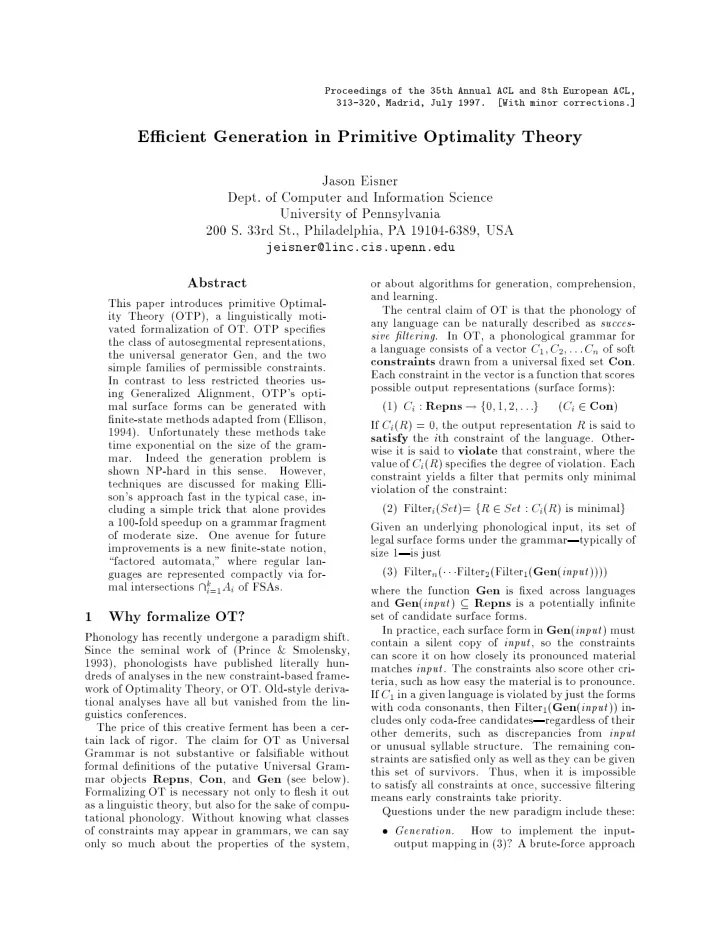

Proceedin gs of the 35th Annual ACL and 8th European ACL, 313-320, Madrid, July 1997. [With minor correction s. ] E�cien t Generation in Prim it i v e Optim ali t y Theory Jason Eisner Dept. of Computer and Information Science Univ ersit y of P ennsylv ania 200 S. 33rd St., Philadelphia, P A 19104-6389, USA jeisner@l inc .ci s.u pe nn. edu Abstract or ab out algorithms for generation, comprehension, and learning. This pap er in tro duces primitiv e Optimal- The cen tral claim of OT is that the phonology of it y Theory (OTP), a linguistically moti- an y language can b e naturally describ ed as suc c es- v ated formalization of OT. OTP sp eci�es sive �ltering . In OT, a phonological gramma r for the class of autosegmen tal represen tations, a language consists of a v ector C ; C ; : : : C of soft 1 2 n the univ ersal generator Gen, and the t w o dra wn from a univ ersal �xed set . constrain t s Con simple families of p ermissible constrain ts. Eac h constrain t in the v ector is a function that scores In con trast to less restricted theories us- p ossible output represen tations (surface forms): ing Generalized Alignmen t, OTP's opti- (1) : ! f 0 ; 1 ; 2 ; g ( C 2 Con ) mal surface forms can b e generated with C Repns : : : i i �nite-state metho ds adapted from (Ellison, If ( R ) = 0, the output represen tation is said to C R i 1994). Unfortunately these metho ds tak e the i th constrain t of the language. Other- satisfy time exp onen tial on the size of the gram- wise it is said to that constrain t, where the violate mar. Indeed the generation problem is v alue of ( R ) sp eci�es the degree of violation. Eac h C i sho wn NP-hard in this sense. Ho w ev er, constrain t yields a �lter that p ermits only minima l tec hniques are discussed for making Elli- violation of the constrain t: son's approac h fast in the t ypical case, in- (2) Filter ( S et )= f R 2 : ( R ) is minim al g cluding a simple tric k that alone pro vides S et C i i a 100-fold sp eedup on a grammar fragmen t Giv en an underlying phonological input, its set of of mo derate size. One a v en ue for future legal surface forms under the grammar|t ypi cally of impro v emen ts is a new �nite-state notion, size 1|is just \factored automata," where regular lan- (3) Filter ( � � � Filter (Filter ( Gen ( input )))) guages are represen ted compactly via for- n 2 1 k mal in tersections \ A of FSAs. where the function Gen is �xed across languages i i =1 and Gen ( input ) � Repns is a p oten tially in�nite 1 Wh y formalize OT? set of candidate surface forms. In practice, eac h surface form in Gen ( input ) m ust Phonology has recen tly undergone a paradigm shift. con tain a silen t cop y of , so the constrain ts input Since the seminal w ork of (Prince & Smolensky , can score it on ho w closely its pronounced material 1993), phonologists ha v e published literally h un- matc hes input . The constrain ts also score other cri- dreds of analyses in the new constrain t-based frame- teria, suc h as ho w easy the material is to pronounce. w ork of Optimalit y Theory , or OT. Old-st yle deriv a- If in a giv en language is violated b y just the forms C 1 tional analyses ha v e all but v anished from the lin- with co da consonan ts, then Filter ( Gen ( input )) in- 1 guistics conferences. cludes only co da-free candidates|regardless of their The price of this creativ e fermen t has b een a cer- other demerits, suc h as discrepancies from input tain lac k of rigor. The claim for OT as Univ ersal or un usual syllable structure. The remaining con- Grammar is not substan tiv e or falsi�able without strain ts are satis�ed only as w ell as they can b e giv en formal de�nitions of the putativ e Univ ersal Gram- this set of surviv ors. Th us, when it is imp ossible mar ob jects , Con , and (see b elo w). Repns Gen to satisfy all constrain ts at once, successiv e �ltering F ormalizing OT is necessary not only to �esh it out means early constrain ts tak e priorit y . as a linguistic theory , but also for the sak e of compu- Questions under the new paradigm include these: tational phonology . Without kno wing what classes of constrain ts ma y app ear in grammars, w e can sa y � Ho w to implemen t the input- Gener ation. only so m uc h ab out the prop erties of the system, output mapping in (3)? A brute-force approac h
Recommend
More recommend